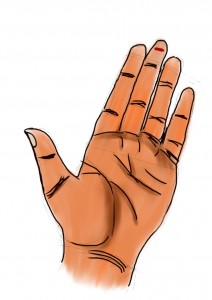Critters (Rats) in the Attic – How I Fixed It
Two weeks ago, one of the tenants complained about the noise in the attic. Perhaps, an unpaid “critter” had taken a residency above them. My heart sank just imagining the work needed to chase out those critters. I had some “bad” experience in the past with a family of possums living in the attic in my previous home. I ended up battling that family for over a year . (I should’ve hired a professional though). I quickly checked and found the attic vent had an opening, thanks to the modern architecture of merging two roof lines, where it forms a natural shelter for animals. See below:

Close up here:

I suspected the unwelcome guests were either rats or squirrels. I assumed it’s probably a rat(s) due to the small hole. Decided to bait the rat with a rat poison like this one for maximum safety consideration:

After a couple of days, I went back to check and found the bait wasn’t even touched. Decided to toss one whole block of bait into the vent to maximumize efficiency. Sure enough. Two days later. The tenant reported a dead rat on the backyard and had since tossed it into the garbage can.
I will check back a couple of weeks to ensure all the rats were killed before sealing the vent back. Another disaster has been diverted.
Happy Valentine’s Day
Book Review: “Parenting Without Power Struggles: Raising Joyful, Resilient Kids While Staying Cool, Calm, and Connected” by Susan Stiffelman

Be the captain of chip in your relationship with your children. There are excellent Question and Suggestion sections at the end of each chapter that answered many of my questions. The 6 stages of attachments are very interesting and are the fuel for our connection to our kids. I also come to appreciate the importance of the “village” attachments in raising a child. There are many other wonderful ideas on approaching problems of anxiety, depression, anger, and etc. It’s very nicely done and a must read for parents.
1. How to be the captain of the ship through calm and stormy seas: Who’s in charge. Ask yourself the 4 questions about your belief or thought that precipitates your upset: 1. Is it true? 2. Can you absolutely know that it’s true? How do you feel (or react) when you think that thought? 4. Who would you be without that thought? Our children want and need to feel dependent on us like in a blackout or disaster. The wonderful advises are: a. Focus on loosening your need for your child to behave properly so that you can feel you’re a good parent. b. Explore the meaning you’re assigning to your child’s problematic behavior. C. Let go of the drama and threats that simply emphasize how out of control you’ve become. d. Come alongside your child, rather than at him, so he feels you’re his ally and advocate. e. Create a plan and stick to it with quiet authority, even at the cost of having your child dislike you. f. Love your child in the way he most needs it: by being the calm confident Captain of the ship as your child navigates the sometimes rough waters of growing up.
2. Attachment and Connection: All relationships including those between the child and parents involve the six stages of attachment by Gordon Neufeld: 1) proximity (through touch, contact, and closeness), 2) Sameness (mimicking mannerism), 3) Belonging or Royalty (“My Mommy!”), 4) Significance (feeling being treasured), 5) Love, 6) Being Known (confide in parents). Be cautious that your kid’s peer attachment with his/her friends are not reliable and mostly conditional.
3. How to help your kids have healthy relationship with the members of their village. Strengthen the attachments with teachers, and other adults of the family, neighborhood/community and friends. Do the same by putting energy in the lives of other children creates a bond that benefits all.
4. Creating an unshakable connection with your kids: Kids want to be able to tell us the truth. Children’s “Neck up and neck down” communication style – be the translator to help them express what they’re feeling (neck down). Find ways to build connections.
5. Helping kids deal with frustration: Frustration fuels aggression. “Our ability to live joyful and successful lives depends on our ability to adapt.” Understand the 5 stages of grief: DABDA (Denial, Anger, Bargaining, Depression and Acceptance). Move your child toward adapting by helping her find her tears.
6. Handling Resistance, anger, whining, meltdowns, and aggression: Use Act I (ask questions for the child to offload his/her upset and to keep the child talking). Act II (Ask permission to offer advises). Get the three yeses from the child by asking if the correct feelings were spoken. “If whining is the answer, what’s the question” – explore the reasons why the child whines or interrupts.
7. How to get kids to cooperate: The need for close and secure attachment is one of the strongest drive that humans have. Kids are inclined to do what you ask when they feel close to you and when you request from a sense of connectedness. There are times when a child’s refusal to cooperate is an indication of unspoken tension in the household, and his resistance is his attempt to exert even a little power within the context of feeling powerless. Give direction from connection (being interested in what they’re doing). Eye contact (“Eye on me” before asking to comply). Requesting into the yes (Get the child to nod and say yeses). Catch them being helpful. Ask “What would she have to be feeling to behave this way?” Use a big fat period.
8. Celebrate the child you’ve got: Accept and see your kids for the remarkable human beings they are.
9. Every child’s a genius: a “genius” as defined as “to give birth” or “to be zestful or joyous.” ADD can be explained by “hunter” vs. “farmer” traits. Having ADD is like being a hunter in a farmer’s world.
10. How to help kids avoid depression and anxiety – and be genuinely happy: When the parent-child relationship is fragile, the prospect of turning to Mom and Dad can seem impossible to a troubled youngster. To deal with anxiety, imagine that “Little Fear Guy” sits on their shoulder and is dedicated to their safety. Distinguish between “shapeless” fear (often attributed to modeled fear from a parent) and “specific” fear. Practice the “ABC” thinking: A (actual events), B (beliefs we construct about the event), C (the consequence of our having the beliefs). “When a thought shows up that has the power to make us sad or angry or anxious, we DON’T have to believe it.”
11. Being present and mindful, and unwinding without electricity: Turn off the gadgets and be present. Kids are like a gift that continues to unwrap itself. Play the suggested games in the book with your kids.
12. Empowering your kids to create their best lives: Five qualities that help youngsters move toward adulthood with the resources needed to find their passion, manage the obstacles that may get in their way, and persevere to making their dreams come true: self-respect, problem-solving, visioning, and gratitude.
13. Live like your kids are watching – because they are: The cameras are always rolling. When we make mistakes, the thing to do is to apologize sincerely, and not justify or blame someone else for making us do.
Learning to Draw on iPad’s Procreate
Learning to draw is one thing and learning to draw on iPad digitally is another. There are many iPad apps for drawing. I’ve tried ArtStudio and Procreate. Both offer very good features. I particularly like Procreate’s feature of creating a video from the drawing in progress. I did have to slow down to the video 4x for ease of viewing below:
Thanks to many amazing Youtube channels like Shoo Rayner’s Youtube channel below, you can practically learn drawing on your desk.:
My Middle Finger Cut – Some thoughts
Last Sunday as I was pruning the frost-damaged tomato plant, I accidentally cut about 1/4″ into the tip of my middle finger. Yes, the pruner is a deadly weapon. I then walked back to the house and asked my daughter to bring out some tissue paper to avoid having my blood dripping all over the floor. When I showed my daughter the cut, instead of sympathy, I got a laugh from her, “Middle finger? Ha ha ha!” Not cool. It didn’t hurt that much but the stung a bit when I applied hydrogen peroxide on it.
Like losing the faculty of any part of your body, you don’t appreciate it until you lose it. Several days since, I have had problems flossing my teeth (the middle finger plays a critical of pivoting the floss to get to the back of the teeth), washing my hair and the right side of the my body in the shower. And of course, typing on the keyboard became a painful experience too.
It’s been five days now. The cut is almost gone and it no longer hurts. The strange thing is that as soon it’s healed, it’s back to normal; I don’t pay any attention to it any more. Like the cliche, the squeaky wheels gets the oil and I might add “a sore middle finger gets pampered.”
I used this opportunity to draw my hand on my iPad with Procreate app as above. You can always turn a painful accidental experience into a learning opportunity.
iPhone/iPad is “Unable to Purchase At This Time” Apps – How I Fixed It
Two weeks ago, I had been experiencing for several weeks “Unable to Purchase At This Time” warning message on my iPhone when I tried to purchase and download an app from the App Store. I googled around and found that it has to do with a bug in iOS 7. There were several recommendations on how to fix it. The one solution that worked for me was to change the keyboard from “US” to “US International” keyboard (Setting ->General -> Keyboard-> Keyboard then select “English – US International” instead of “US”). After power cycling the iPhone by holding Sleep & Home buttons at the same time, now I was able to purchase and downloads Apps on the App Store. All the Apps were queued up to download all of the sudden. I thought that was the end of the story. But no, yesterday, the problem acted up again. This time, I selected “English – US Extended” keyboard and it started working again. I suspected this bug may have something to do with the fact that I have turned on several keyboards (English + Chinese).
Also, about the same time, I was experiencing a constant prompting for Apple ID and Password for the iCloud backup on my iPad. I applied the same trick and I haven’t seen the problem since.
So there you have it. Switching around US keyboards among all US keyboards may fix the problem. What a strange bug it is!




